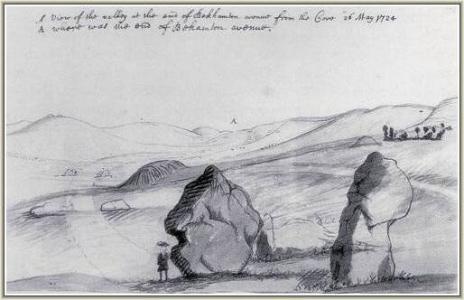Beaker Ware
Beaker Ware is in Pottery.
West Kennet Long Barrow [Map] is a Severn Cotswolds Tomb type tomb, probably constructed in the 3700s BC. Human bones of men, women and children were placed in the chambers between 3670 and 3635 BC. The site appears to be subsequently re-used between 3620 and 3240 BC. In the late Neolithic it was blocked up with the addition of large sarsen boulders. It is 100m in length, 20m wide, constructed from earth with ditches on both sides, oriented east-west. At the east end are multiple chambers formed off a passage that extends 12m into the barrow. The ceiling is between 1.7 and 2.2m high - sufficient to allow an adult to stand upright.
Finds included Grooved Ware, Beaker Ware, Ebbsfleet Ware, Mortlake Ware and Fengate Ware coming from more than two hundred and fifty vessels.
Knap Hill [Map]. Historic England 1005704.
Summary: The site of Knap Hill, a Causewayed Enclosure. It encompasses an area of circa 2.4 hectares and consists of a single circuit of sub-triangular plan, conforming to the contours of the hill and possibly incomplete on the steepest, southern side. Exceptionally compared to other enclosures, the causeways seem to correspond precisely to gaps in the bank. It is unclear if the earthworks ever formed a complete enclosure. Excavations by the Cunningtons in 1908-9 first demonstrated the causewayed nature of the earthworks, as well as recovering pottery which they felt to be Neolithic in date. Further excavations in 1961 confirmed the Cunningtons' observations. Romano British pottery and an extended inhumation probably relates to the adjacent, later earthwork enclosure. The site and its archaeological history were re-investigated as part of the RCHME project focusing on enclosure and industry in the Neolithic period in 1995. Knap Hill was also subsequently included in a research programme into the dating of the early Causewayed Enclosures of southern Britain and of Ireland. The results suggested that Knap Hill was probably constructed in the 35th century cal BC, (that is to say between 3500-4001cal BC) probably more than a century later than Windmill Hill and the West Kennet long barrow [Map]. It is unclear, however, for how long activity continued. On the basis that the ditch was left to infill naturally, that there is no sign of recutting, and because there is a scarcity of sherds and bones, a short duration, probably of well under a century and perhaps only a generation or two, is possible.
More information: (SU 12106368) Neolithic Camp (NR) Knap Hill (NAT).
A causewayed camp on Knap Hill (see plan), excavated by BH and ME Cunnington in 1908-9 and G Connah in 1961. The excavations revealed Windmill Hill sherds in the silting of the ditches, Beaker sherds on the surface of the ditches and Romano-British sherds, probably associated with the plateau enclosure (see SU 16 SW 13). Other finds nearly all from within a few feet of the bottom of the ditch include fragments of red deer antlers, a human jawbone, flint flakes and a few sarsen chips. The finds are now in [Map]. Connah concludes from his excavations that the causewayed ditches undoubtedly belong to the Windmill Hill culture and that the scarcity of the pottery and occupation material may suggest that the camp was of a defensive character and abandoned at an early stage - perhaps before completion.
Radiocarbon dating of antler fragments from the primary rubble of the ditch - 4710+- 115 BP or 2760BC. Charcoal from the upper silting of the ditch - 3790+- 130BP or 1840BC.
SU 12106365 Knap Hill causewayed camp occupies a hill top position overlooking the Pewsey Vale to the S. The causewayed bank can be traced only on the N and W sides, but accepting the natural gradient of the hill for the eastern and southern extent, then the area enclosed would have been approximately 1.7 hectares. There is a bowl barrow (see SU 16 SW 23) and some flint digging disturbance within the camp, and in the E the perimeter of the IA/RB "plateau" enclosure obscures the terminal on the causewayed bank. Resurveyed in conjunction with RCHM manuscript plan at 1:2500.
The Neolithic causwayed enclosure and associated features described by the previous authorities have been mapped at 1:10,000 scale from aerial photographs and the 1:1000 plan produced as part of the industry and Enclosure in the Neolithic Project (Event UID 923509).
Surveyed by the RCHME as part of the above project.
Knap Hill encloses an area of 2.4 hectares and consists of a single circuit of sub-triangular plan, conforming to the contours of the hill and possibly incomplete on the steepest, southern side. Exceptionally to other enclosures, the causeways seem to correspond precisely to gaps in the bank.
Two radiocarbon dates were obtained by Connah following his 1961 excavations (Table 3.3: BM-205, -208; Connah 1969). They bracket the infilling of the ditch, the sample for BM-205 coming from near the base and that for BM-208 from the topmost fill. BM-205 was measured on an antler implement which had arguably been used to dig the ditch and would have been contemporary with that event. BM-208 was measured on an unidentified bulk charcoal sample which may have included material of diverse ages, and can hence provide only a terminus post quem for its context.
Knap Hill was included in a research programme into the dating of the early Causewayed Enclosures of southern Britain and of Ireland, using chronological estimates produced by Bayesian statistical analysis of radiocarbon dates. In addition to attempting to establish a construction date and duration for the monument, the proximity of the site to Windmill Hill and to a concentration of long barrows posed the question of its chronological relation to them. Six further radiocarbon measurements were therefore obtained. A model which incorporates this interpretation of the archaeological sequence with the radiocarbon dates was constructed. The model suggested that Knap Hill was probably constructed in the 35th century cal BC, probably rather more than a century later than both Windmill Hill Causewayed Enclosure [Map] and the West Kennet long barrow [Map]. It is unclear, however, for how long activity continued at this enclosure. On the basis that the ditch was left to infill naturally and there is no sign of recutting, and because there is a scarcity of sherds and bones, a short duration, probably of well under a century and perhaps only a generation or two, is plausible.
The Amesbury Archer [Map] is the remains of a man aged around forty at the time of his death from the Alps who was buried in Amesbury around 2300BC and discovered in May 2002 during the development of new housing. He is named 'The Archer' as a consequence of the large number of arrowheads found with him. His grave contained the largest number of artefacts of any grave of a similar period including the earliest known gold objects in England, five beaker funerary pots, three tiny copper knives, sixteen barbed flint arrowheads, a kit of flint-knapping, metalworking tools including cushion stones and some boar tusks. On his forearm was a black stone wrist guard. A similar red wrist guard was by his knees with a shale belt ring and a pair of earrings, the oldest gold objects found in England. An eroded hole in his jaw showed that he had suffered from an abscess, and his missing left kneecap suggests that he had an injury that left him with a painful lingering bone infection. His remains are on display in the Salisbury and South Wiltshire Museum [Map].
The Amesbury Archer's Companion is the remains of a man raised locally aged between twenty-five and thirty at the time of his death buried around 2300BC near to the Amesbury Archer. He appears to be related to the Amesbury Archer as they shared a rare hereditary anomaly, calcaneonavicular coalition, fusing of the calcaneus and of the navicular tarsal (foot bones). Inside his jaw were found a pair of gold earrings or hair ornaments in the same style as the Amesbury Archer's.
Photos sourced from Salisbury and South Wiltshire Museum [Map] and Wessex Archaeology.
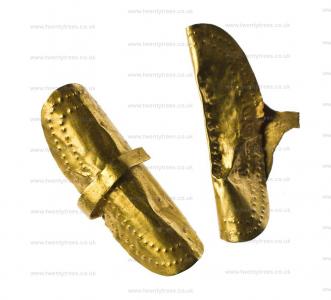
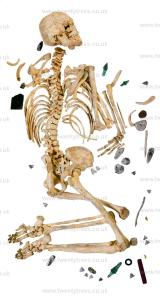
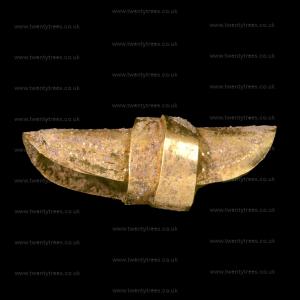
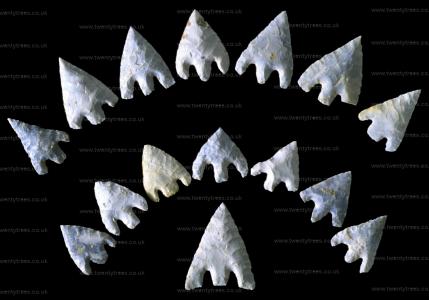
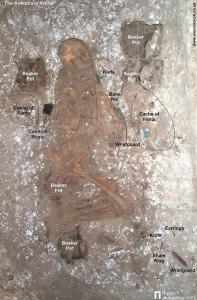
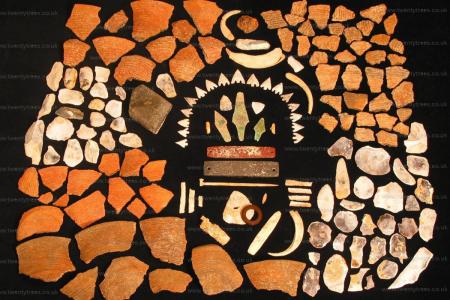
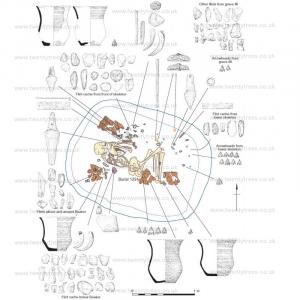
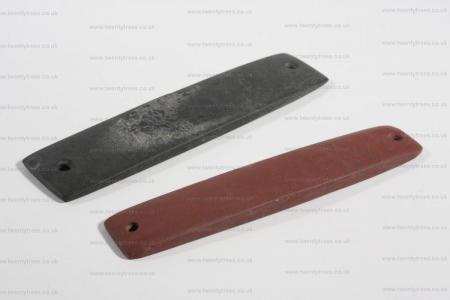
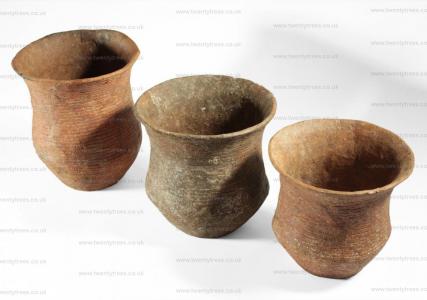
Archaeologia Volume 15 Section XXXIII. The third, a circular tumulus [Boyton Barrow 2 [Map]], see Plate XVI fig. I. in Boyton manor, is situated on a neck of land, projecting from the great ridge wood, to Stockton sheep pond, having Dean Valley on the right. This barrow is 40 feet in diameter, and 3 feet nine inches in elevation; at the depth of four feet in the native chalk, (7 feet 9 inches from the top of the barrow,) we found the skeleton of a young person [h] lying with the head nearly east, this circumstance is unusual in what I have supposed primary interments, viz. where skeletons are interred at a great depth in a barrow; in such cases the head generally lies to the north, or nearly so. [i] The bones were in very good prefervation, and the teeth, (a most beautiful set,) were perfectly white. Near the feet of this skeleton, lay the fragments of a very handsome drinking cup; [k] about a foot from this, we found another very small cup, both of which I have since repaired by a cement, which has enabled Mr. Crocker to make good drawings of both.
The large cup, [l] or vase, holds nearly two quarts: it is of a brick colour, and on first sight might be mistaken for the Roman Samian pottery, but, on a nearer view, you perceive (notwithstanding the neat appearance,) that it is very imperfectly burnt, and that the ornaments are done by the hand, without a lathe; it stands 9 inches high, and measures 6 inches over the brim, see Plate XVII. Fig. 1. The small black cup is, in size and form, like some modern cream pots; it is 3¼ inches high; see Fig. 2.
Note h. I suppose from 20 to thirty years of age.
Note i. On top of barrows, we find the fkeletons in every direction.
Note k. The wide brim and large size rather militate against appropriating those vessels to this purpose.
Note l. This is the largest drinking cup I ever saw.
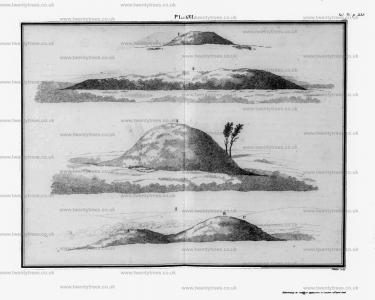
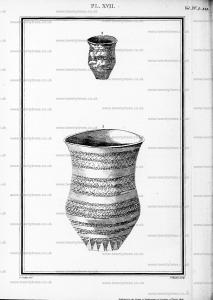
Section I Tumuli 1843. The first tumulus opened this season was situate upon the Meadow-place Farm, near Yolgrave, and is generally known as Bee Lowe [Map]; it was decided upon to open it on the 16th of June, when it was found to be impossible to excavate it in a proper manner, owing to the trees growing upon the sides; therefore the only method of examining it was by sinking a hole down the centre of the mound, which consisted of loose earth and stones, amongst which a profusion of rats' bones was met with. In the course of this excavation the broken fragments of a human skeleton were turned up, which made it evident that one interment at least had been disturbed at some former period. Amongst these bones were found a small arrow-head of flint, elegantly formed, two rude instruments of the same material, and about half a dozen horse's teeth. On reaching the native soil, which was about four feet from the top of the barrow, the primary deposit was found, consisting of burnt bones, amongst which was part of a bone pin, also calcined; and near to the same place lay some fragments of a well-baked clay urn, very tastefully ornamented with a chevron pattern, and which had been of the form of vessel designated "drinking cups" by Sir Richard Hoare, by which name they will be distinguished in the subsequent parts of this work, as a simple way of expressing their difference from the sepulchral urns and incense cups, although it is by no means certain that they were made use of for the purpose implied by the words "drinking cup."
Section I Tumuli 1843. A smaller barrow having been discovered in the immediate vicinity of the foregoing it was opened on the 12th of July, 1843. Its small size and comparative low situation had undoubtedly prevented its being known as a barrow and are probably the reasons of its being destitute of any distinctive appellation. About a foot from the top in the middle part of the mound two skeletons were discovered one of which was nearly entire, the other seemed to have been disturbed. With these were found the fragments of a coarse dark-coloured urn, a flint arrow-head, a small piece of iron, part of a bridle-bit, and several horses' teeth. A complete stratum of rats' bones surrounded these bodies. Proceeding lower down, a cist, formed of large flat limestones, placed on edge, was disclosed; it was entirely filled up with very fine mould, which being removed, exposed two skeletons in an extremely decayed condition. Near the heads of these was placed a deposit of burnt human bones; and lower down, in the cist, an iron knife or dagger, contained in an iron sheath, was found. The south side of this tumulus being found to extend considerably further from the central point than any other part of the circle, it was thought that it might contain more interments, such having been proved in the case of a similarly extended barrow (Galley or Callidge Lowe [Map], 8d of July, 1843); and the result substantiated the correctness of this opinion, as on removing the soil to a very inconsiderable depth, a skeleton, evidently of a young person, was found to lie with its head towards the interior of the tumulus, and close to a quantity of calcined human bones; near the shoulders lay a highly-ornamented drinking-cup, a small brass or copper pin, pointed at each end, and a rude spear- or arrow-head of gray flint. In the immediate neighbourhood of this interment several horses' teeth and other animal bones were noticed.
Section I Tumuli 1843. July 14th, 1843, one of the most interesting barrows ever examined in this vicinity was opened. It is situated upon a ridge of high land, near the village of Biggin, which goes by the name of the "Liffs [Map]," the barrow itself having no specific name: the mound had been sadly mutilated, at least one third of it having been removed; notwithstanding this the truth of Sir Richard Hoare's maxim, "fronta nulla fides," was agreeably exemplified. That hemisphere of the circle which still remained the most perfect was selected as the place where to commence operations: on reaching the thickest part of the circle, which, owing to the depression usual in the middle of most barrows, would be about two yards from the centre, a few human bones, horses' teeth, various animal bones, and two small pieces of a very thick and coarse urn, were found; but not until penetrating to the heart of the barrow was the principal interment discovered. In that situation an octagonal cist was erected of the usual material, namely, thin flat lime-stones, which are admirably adapted for the purpose; this vault was about half filled with stiff clay, imbedded in which lay a fine human skeleton, whose knees were drawn up, according to a general custom, prevalent in the most remote ages. The extreme antiquity of this interment is demonstrated by the simple form and material of the weapons and tools which were, with one exception, deposited in a cluster behind the shoulders of this early denizen of the Derbyshire moors. The skull, which is fine and intellectual, lay on the left side so as to look towards the west, and in the angle formed by the contraction of the knees, was placed a hammer-head ingeniously constructed out of the lower part of the horn of a noble red deer; one end of this instrument is rounded and polished, the other is cut into a diamond pattern, somewhat similar to the wafer stamps used by attorneys. The articles before alluded to as being placed near the shoulders were of a very miscellaneous character, and highly interesting; as showing, after a lapse of several thousand years, that the savage Briton reposing in this cairn had cultivated the art of making war amongst the inhabitants of the forest, in preference to molesting his fellow-savages; as almost the first observed articles were a pair of enormous tusks of the wild boar, the trophies of some, perhaps his last, sylvan triumph; next came two arrow-heads of flint, delicately chipped, and of unusual form; two flint celts or chisels, beautifully chipped and polished at the cutting edges; two spear-heads of the same material; two flint knives polished on the edge, one of them serrated on the back, in order to serve as a saw; and numerous other pieces of flints of indescribable form and use, which, together with all the flint instruments enumerated above, seem to have undergone a partial calcination being gray tinted with various shades of blue and pink; with these utensils were found three pieces of red ochre, the rouge of these unsophisticated huntsmen which, even now, on being wetted imparts a bright red colour to the skin, which is by no means easy to discharge. Upon the summit of the little heap, formed by this accumulation of relics, lay a small drinking or incense cup of novel and unprecedented shape, which was unfortunately broken and crushed, but has been since restored. The absence of instruments of metal in this and other barrows should be borne in mind; it is commented on in another part of this work.
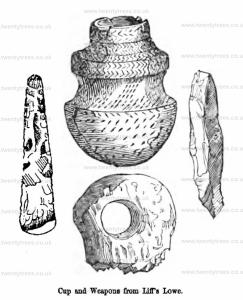
Section I Tumuli 1844. The 8th of May, 1844, was opened a barrow called Sliper Lowe [Map], upon Brassington Moor; this tumulus is about twelve yards in diameter, and not more than a foot in height, being probably much reduced by its being frequently tilled; which was made evident by the disturbed and shattered state of some human bones which lay just beneath the turf. On making sections through the mound from the four cardinal points, the remains of three human skeletons were found much disturbed; bones of various descriptions of animals, amongst them the skull of a polecat, same as those previously found at Bole Hill [Map], (July 30, 1843,) and rats' bones, a small fragment of a stone celt, five instruments of flint, and various chippings of the same. On arriving at the centre, a deposit of burnt bones was discovered, from amongst which were taken two arrow-heads, and two other instruments of flint. The surface upon which this interment lay was perceived to be soil, whilst the other parts of the barrow had a level floor of rock; this suggested the idea of a cist being cut in the rock, which on examination proved to be the case, as a circular cist was found to be sunk to the depth of two feet, on the floor of which lay the skeleton of a child, apparently about ten years of age, above this was deposited a drinking-cup of elegant form, and elaborately ornamented, and which when found was still in an upright position, as it had been originally placed. There were no traces of any ornaments having been buried with this juvenile Briton.
Section I Tumuli 1844. June the 10th, 1844, was opened a barrow [Map] upon Elton Moor, for which there is no distinctive name; it was on this occasion divided into four quarters by our sections, which left very little of the mound unexplored. In the usual central situation was found a previously-disturbed interment, accompanied by a large arrow- or spear-head of flint, a piece of a small urn neatly ornamented, and some animal teeth. On the southern side of the tumulus another interment was discovered, about eighteen inches below the natural surface of the land upon which the barrow was constructed; this skeleton was certainly that of an aged person, the teeth being much worn down; near the head was a piece of spherical iron pyrites, now for the first time noticed as being occasionally found with other relics in the British tumuli. Subsequent discoveries have proved that it was prized by the Britons, and not unfrequently deposited in the grave along with the weapons and ornaments which formed the most valued part of their store; even to the present day, the same mineral is used as a personal decoration by some tribes of the South American Indians. In the rear of the skeleton was a neatly-ornamented drinking-cup, which had been crushed by the weight of the soil, with which it had in a great degree become incorporated; within this cup the following odd assemblage of articles were placed: three quartz pebbles, one of which is red, the other two of a light colour; a flat piece of polished iron ore, a small celt of flint, with the peculiarity of having a round polished edge, instead of a cutting one as is usual; a beautifully-chipped cutting tool, twenty-one circular instruments almost all neatly chipped, and seventeen pieces, or rude instruments, all of flint, which had been turned to a delicate white or gray by calcination. Scattered about in the immediate neighbourhood of this interment were a good many pieces of burnt bones, not sufficient in quantity to compose a complete deposit, and a few rats' bones as usual.
Section I Tumuli 1844. On the 31st of July, 1844, a small barrow [Map] on the One-ash Farm was opened; it was very low, being in no place more than a foot above the surrounding ground; owing to this circumstance the bones had been much disturbed and broken by the passing of the ploughshare over the mound. Near the centre of the barrow were the remains of a human skeleton, which had been accompanied by an ornamented drinking-cup, now broken to fragments; about the same place were perceived a great number of rats' bones, a few horse's teeth, a part of a boar's tusk, and a piece of rubbed sandstone, which had been burnt until it had become quite red, together with a few bits of flint. In other parts of the tumulus human bones were discovered, which would indicate this barrow to have been the resting-place of about six ancient Britons.
Since the above account was written it has been ascertained that this tumulus was opened in 1818, by Mr. Samuel Mitchell, who discovered part of a neatly-ornamented urn, about six inches in diameter, which had contained calcined bones; also some animal bones and an entire human skull.
Section I Tumuli 1844. On the 6th of August 1844 was opened a most interesting barrow upon Wardlow Common which is known by the name of Rolley Lowe [Map]; it is a mound of considerable magnitude, being forty-five feet in diameter, and five feet in height at the centre. As the discoveries made in this barrow are of a very miscellaneous character, and of various dates, it will be the most simple course to record them in the order in which they occurred: in the course of the central excavation, in which all the relics were found, about a foot from the surface, and dispersed amongst the soil which was found to be unmingled with stones to the depth of eighteen inches, were found a few human bones and teeth, and a third brass coin of Constantino the Great; near the bottom of this upper stratum of soil, where it began to be slightly mixed with stones, a brass pin, two inches and three quarters in length, square at the thicker end for insertion into a handle, was found. About three feet from the surface of the mound, a central area about eight feet in diameter was discovered, which seemed to be walled out in a circular form, and divided into five partitions by large limestones, so as to exhibit a ground plan similar to a roulette-table. There was no appearance of any of these vaults having been protected by coverings; when discovered, each was filled with small stones, amongst which lay the skeletons, which occupied all these partitions, whilst in one was also an urn. But to resume the particulars in the order before stated; in the first examined recess was a human skeleton, minus the head but complete in other respects; with this interment was deposited the under jaw of a child; in the next compartment was a skeleton without any accompaniment: in the following cist was a large and coarse urn, inverted over a deposit of calcined human bones, amongst which was a large red deer's horn, also calcined; the urn was about sixteen inches in height, and twelve in diameter; and, owing to its size and fragile texture, was broken to pieces in the attempt made to remove it; near the urn was a skeleton with a fine and well-preserved skull. In the last examined division, which was the northern-most, lay a human skeleton, with which were deposited a large horn from the red deer, and the jaw of an otter. Proceeding down about a foot lower than the level upon which all these skeletons were laid, another skeleton was found laid upon a large stone, on the level of the natural soil; it was accompanied by three rude instruments of flint, and the head lay directly beneath the large urn before mentioned: the stone in question measured in length six feet, and in breadth about four feet, being upon the surface of the ground it was at first thought to be rock but a piece being broken off, disclosed to view a sight such as is seldom witnessed by the barrow-digger, and which repays him for his frequent disappointments; this was a cist or vault, three feet in length, two feet in width, and eighteen inches in depth, formed of four smooth limestone slabs, having a fifth as a pavement, all the angles and joints having been so effectually secured by a pointing of tenacious clay, that not a particle of soil had entered this primitive coffin, the workmanship of which was in every respect neat and accurate. It was tenanted by a skeleton with contracted knees, whose bones, though much decayed, lay in the posture they had assumed on the decomposition of their fleshy covering; in the rear of the skeleton, was laid on one side a highly ornamented urn, of rude but chaste design, and in various situations in the cist were found two very neat arrow-heads of flint, of uncommon form, a large tusk of the wild boar, seven inches in length, and a piece of tempered clay, to which adhered some fragments of decayed wood. The excavation for the vault was made in the natural soil, and from the floor of the cist to the summit of the tumulus was at least six feet six inches. The undermentioned articles, which did not appear to be connected with any of the interments, were found in various situations, throughout the interior of the barrow; namely, a fragment of an ornamented drinking-cup, a spear-head of coarse flint, and similar workmanship, a few animal teeth, and rats' bones "ad infinitum." The outer circumference of the major part of this barrow was constructed of some description of clayey composition, which had become as hard as a turnpike road.
Thomas Bateman 1845. In the afternoon of the same day a far more interesting barrow was opened, the name of which is Green Lowe [Map]. It is situated upon the tract of land known as Alsop Moor which has since proved very productive of ancient British remains. This tumulus had been heaped over a rocky and unequal surface, in which a hole had been cut in order to serve the purpose of a cist. In removing the upper portion of the barrow a few human bones, horses' teeth, and rats' bones were discovered, and on clearing out the soil with which the cist was filled, the skeleton of a man in the prime of life was laid bare; his knees were contracted and drawn up until they nearly approached the head; and immediately in the rear of the shoulders were placed an elegant and most elaborately-ornamented drinking-cup, a piece of spherical pyrites, or iron ore, before alluded to as being an occasional ornament of the Britons, a flint instrument of the circular-headed form, and a splendid flint dagger; a little lower down the back of the skeleton there lay three beautifully-chipped and barbed arrow-heads of flinty seven other instruments of the same material but of inferior workmanship and three instruments made from the ribs of some animal neatly rounded at each end and much like a mesh-rule for nettings or perhaps used as modelling tools in the construction of urns. Still lower down, close to the pelvis, lay the remains of an infant; across the pelvis lay a bone pin, made from the leg of a small deer, which had probably been used to secure the folds of some vestments in which the body had been enveloped previous to its interment. The contents of this barrow are highly interesting, as they present a striking degree of similarity to the contents of barrows discovered in Wiltshire, particularly to the relics engraved in plate 18, vol. i of Sir Richard Hoare's work. The drinking-cup there figured bears a characteristic resemblance to the one here discovered, which is quite different to any heretofore found in Derbyshire; indeed, had railways then existed, and communication with distant places been as easy as at the present day, we should have attributed both vessels to one designer and manufacture. All the flints here discovered had undergone the action of fire, and present a spotless white, which materially improves their appearance.
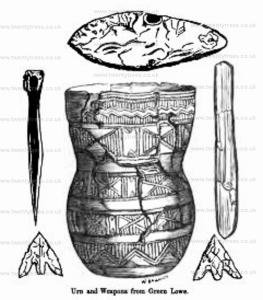
Thomas Bateman 1845. On the 7th of June 1845, was opened a large barrow near Wetton in Staffordshire, situated upon a piece of ground called the Three Lowes [Three Lows Barrow 1 [Map], Three Lows Barrow 2 [Map] or Three Lows Barrow 3 [Map]], which, as its name would signify, no doubt contains that number of tumuli; indeed there is a small one within fifty yards of the one now about to be described. In the centre was a cist, about eighteen inches deep, cut in the natural rock, which, the height of the barrow being included, was about five feet from the surface; in this cist was a human skeleton, which had evidently been interred in a sitting position, and whose left arm had been broken, and the bones united again in a very crooked form. By the side of this skeleton was a coarse urn in a very decayed state, having never been properly baked; dose to this nm lay a deposit of calcined human bones, amongst which was an instrument of flint, also burnt; a few inches above the cist, part of another urn, enriched with a lozenge-shaped ornament, and part of another human skull were found. In another part of the interior of the barrow were the remains of a large fire covering the floor for a considerable space; amongst which were many imperfectly burnt human bones, which had never been collected together, but had been left amongst the charcoal; upon this stratum of bones and ashes was laid the skeleton of a young person, aged about fourteen, with whom a rude arrow-head of flint was deposited; about six inches above this skeleton was another, which was that of an infant. In another part of this tumulus there was an adult skeleton, which had been previously disturbed; in various situations in the barrow, but more especially towards the outer part of the circle, were portions of red deer's horns and in one instance a perfect pair was found, which it was impossible to preserve complete, on account of their advanced state of decomposition; with them three flint arrow-heads of the rudest form were found, and in the immediate neighbourhood bones of dogs and rats; near the surface in the centre were collected remains of three ornamented urns, or drinking-cups, which had been destroyed by some former excavators, most probably lead miners, who had dug into this tumulus from a mistaken notion of its origin.
Thomas Bateman 1845. On the 21st of June, 1845, an attempt was made to open a large barrow near Alstonefield, Staffordshire, called Steep Lowe, measuring about fifty yards in diameter, and about fifteen feet in central elevation which is constructed almost entirely of loose stones. It was found, on reaching the place, that some of the neighbouring villagers had already, in a vain search after imaginary treasure, found near the apex of the mound, the body of a Romanized Briton, extended on its back, accompanied by an iron spear-head, a lance-head and knife of the same, placed near the head, and three Roman coins, in third brass, namely; one of Constantine the Greats one of Tetricos, the other illegible firom the friction of sand-paper applied by the finder, in the delusive hope of making evident its golden character. They also found some pieces of a highly-ornamented drinking-cup, a curious piece of iron ore, and various animal bones, amongst others, horses' teeth, and rats' bones. All the antiquities discovered by these enterprising individuals were ceded to the writer, on their being reimbursed for their labour and loss of time. On continuing the excavation, there was discovered close to where the spears were found a small stud or circular ornament of copal amber, perforated with a double hole at the back for attachment, in a similar manner to the two ornaments found on Alsop Moor on the 4th of June. In the opposite direction was found a large plain urn of globular form, with four holes through the upper edge, containing a deposit of burnt human bones, two quartz pebbles, and a piece of flint; it was not more than one foot six inches beneath the surface. An attempt was made to penetrate to the floor of the barrow, but owing to the great depth, and the loose nature of the stones, of which the mound is composed, it was found advisable to desist, on account of the hazardous nature of the undertaking, when the excavation had reached the depth of about six feet. It is evident that there yet remains the original interment, and it is by no means unlikely that there may be many more in the interior of the tumulus, which could not be thoroughly examined without a great deal of time and labour being expended.
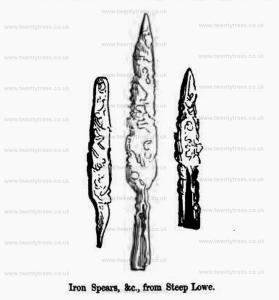
Thomas Bateman 1845. In the latter end of May, 1846, a tumulus at Deepdale, near Wetton, Staffordshire, was opened, which had been previously much disturbed. In addition to the usual quantum of dislocated human and animal bones, portions of a very elegant drinking-cup of imperfectly baked clay, and a piece of lead wire in the form of a bracelet, for which purpose it had probably been used, were discovered; to which may be added a few rude instruments of flint, some of them little better than mere rough chippings.
Thomas Bateman 1846. On the 29th of July, 1846, was examined a large tumulus at Castern [Note. Castern Barrow [Map] has no tumulus marked near it on the OS Map?], near Wetton, Staffordshire, distant about a quarter of a mile from that opened near Castern [Map] on the 14th of June, 1845 (on which occasion the one under notice first attracted attention); it was composed principally of a very solid kind of soil, intermixed with clay, amongst which were dispersed many chippings of flint, as well as others of a more determinate form; also a few animal bones, such as fragments of deer's horns, teeth of horses, &c. Towards the centre the stiff earth did not prevail so much, that part of the mound being constructed of loose stones, which were found to continue below the natural surface, to the depth of four feet, making an entire depth of eight feet from the summit of the barrow; at this depth lay the original and most important interment, in a square cist cut out of the primitive rock; the skeleton lay upon its left side, on a thin bed of very tenacious blue clay, with the knees contracted, accompanied by the most elegant and elaborately ornamented drinking-cup, or vase, hitherto discovered and one small instrument of calcined flint; the vase was placed in an upright position about a foot in the rear of the skull, and exhibited signs of having been two thirds full of some substance, or rather liquid, at the time of being buried, an incrustation having formed inside, at about one third of its depth from the mouth. The skeleton was that of an individual rather above the common size, the large bones of the thigh measuring in length nineteen inches and a half, and all the bones having the ridges and other points of muscular attachment remarkably well developed. At a short distance from the centre of the barrow there was every appearance of the remains of a fire which had been made upon a flat stone, surrounded by others, the edges of which were calcined until they were converted into lime. Can this be the place where the drinking-cup was baked? - there were certainly no calcined bones to be seen. Another body was found in a similar position to the foregoing, within six inches of the summit of the tumulus; it owed its preservation mainly to a large flat stone which was placed over it, and which was literally destitute of turf, and exposed to the observation of any person walking over the barrow. Neither urn nor weapon accompanied this interment.
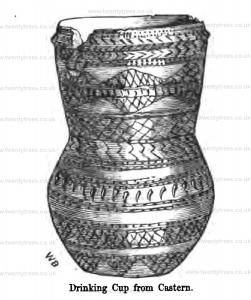
Thomas Bateman 1846. The other barrow [Map] [Note. Calling Low Barrow 2 [Map]] is a lowly sepulchre, not rising more than a foot above the surrounding field, and situated nearer the Yolgrave and Buxton road than the preceding one is. About two feet from the surface, in the centre, and consequently beneath the natural level, was a skeleton inclosed in a mass of stiff earth, which had almost effected the destruction of the bones; near the pelvis of this body a rude instrument of calcined flint was found; it was the only relic deposited with this interment, which had, undoubtedly, supplanted the rightful occupants of the tomb: this circumstance was proved by the discovery of the remains of two previous interments, which had been thrown on one side to make room for the intruder. These I relics comprised many pieces of two unbumt skeletons, parts of two highly-ornamented drinking-cups, and many bones of animals, amongst which the remains of rats were as usual most numerous.
Kenslow Barrow. February 2nd. - The trenching of the barrow was continued, disclosing, near the centre, a depression below the natural level, which had contained the deposits formerly exhumed. In the course of the day pieces of three different urns were observed, one of coarse material and workmanship, another having been a neatly ornamented drinking cup, and lastly of a kiln-baked vessel of brick-red colour that had been made upon the wheel, and which must be therefore much more modem than the two former. There were also found three more of the bone crescents, part of a large ring of inferior jet or Kimmeridge coal, a small spatula of bone, probably used in the fabrication of pottery; a few instruments of flint, human and animal bones, both burnt and unbumt, and a tine from a stag's horn which has been roughly cut round, most probably with a flint saw.
Kenslow Barrow. February 4th. - The grave was very carefully cleared out, but yielded nothing further except a few burnt bones. In other parts of the mound we met with a seventh bone crescent, a bone javelin point, and some more flints. A comparison of the various relics found in this barrow in 1821 and 1848, with others brought to light in the course of these researches, demonstrates not only their varied antiquity, but also the order in which the successive interments had occupied the central grave. The first would be by cremation, the incinerated bones being placed in a coarse sepulchral urn, the fragments of which are before alluded to. The second would evidently consist of an unburnt skeleton, accompanied by a highly ornamented drinking cup, a decoration formed by a combination of the bone crescents, the bone lance heads, and the most carefully wrought instruments of flint; some of the latter would, however, be equally likely to pertain to the oldest interment.
The next occupants of the grave had not been disturbed until he former opening of the barrow in 1821, they were then described as being two in number, though sufficient care was not taken to discriminate the relics found with each: it is quite clear that the lowest (some of whose bones we found unremoved) had possessed the stone axe and the polished stone implement found in 1821, in addition to the bronze dagger found in 1848.
The other which lay higher up in the grave was of much later date, being the owner of the kiln-baked vessel, the iron knife, and the small copper fibula or ring-pin, found in 1821. The vessel appears, from the fragments remaining, to have had a narrow neck, and to have resembled that found at Brun-Cliff [Map] in 1847, (see Vestiges, page 101) in form, colour, and paste. It is the skull of this latest, and perhaps Romano-British skeleton, that is described in the former work.
Parsley Hay. March 6th was passed in opening a cairn or tumulus [Map] [Parsley Hay Barrow [Map]] of stone in a plantation near the Parcelly Hay wharf of the Cromford and High Peak Railway. We found the primary interment beneath the middle of the barrow, in a small oval excavation in the rook below the natural surface of the land, about three feet in depth, and not exceeding the same in its greatest diameter, consequently the body had been placed upright in a sitting or crouching posture, as was abundantly evident from the order in which the bones were found. The grave was roughly covered in with large flat slabs of limestone, which had prevented the material of the tumulus from quite filling it up; a good deal of earth had, however, been washed in, which had the effect of preserving the bones in unusual perfection. The remains accompanying the body were of the poorest description, consisting merely of three pieces of chipped flint, some shreds from a drinking cup, and various animal bones and teeth, some of which were calcined. The fine skull from this interment has been engraved in the magnificent work by Messrs. Davis and Thumam, entitled "Crania Britannica," where its internal capacity is given at 72½ ounces; length of the femur, 18.3 inches. The high antiquity of this interment may be inferred when we take into consideration the fact, that upon the covering stones there lay another skeleton, quite unprotected from the loose stone of the barrow, and accompanied by weapons indicating that the owner lived at a very remote period. This body was badly preserved, owing to the percolation of water through the over lying stones, but it appeared to have been laid as usual upon the lefl side, with the knees slightly advanced; near the upper part of the person were placed a very elegantly formed axe head of granite, with a hole for the shaft, and a very fine bronze dagger of the earliest or archaic bronze period, with three studs for fastening the handle. The engraving gives an accurate section of this remarkable barrow,
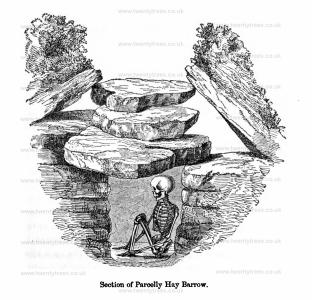
Mouse Low. June 21st, opened a barrow between Deepdale and the village of Grindon, called Mouse Low [Map], fourteen yards diameter and not more than two feet high; the lower part composed of stiff clayey soil, plentifully interspersed with small pebbles; in the centre was a cist constructed of three large flat stones, the fourth side being left open; it was paved with very thin slabs of blue limestone, and contained the skeleton of a very large and strongly built man resting on his left side in the usual contracted posture, near whose head was a peculiarly elegant and well finished drinking cup, 8¼ inches high, inside of which were two implements cut from the ribs of a large animal (compare with those found with a similar interment at Green Low [Possibly Green Low Barrow [Map] but may be a different Green Low], in April, 1845, Vestiges page 60), a spear head, and two beautiful barbed arrows of white flint; outside the cup were two more arrows of the same kind. The skull is very large, and is remarkable from the presence of a frontal suture, although by no means that of a young man; the teeth are in fine preservation; and the skull is of the platy-cephalic variety, occasionally found amongst Celtic crania. In other parts of the mound numerous pieces of human bone, stag's horn, and a neat circular ended flint, were found. And as far as our trench extended, which would be about five yards, it exposed a row of large boulders of hard red grit, laid on the surface of the natural soil in a direction coincident with the longest side of the cist; the smaller limestones near these were almost turned to lime from the effect of heat, and were mixed with burnt bones and charcoal.
Dowel or Dower. July 10th we opened a small mound on the summit of a hill called Brownedge, near Church Stemdale; it was raised about two feet above the natural level, and covered a grave three feet deep cut in the sandstone rock. The grave was filled, and the barrow was entirely constructed with stones mostly of grit, but with the addition of a few pieces of limestone, which must have been carried a mile or two to the place. Having removed these materials to within six inches of the bottom of the grave, without meeting with anything more important than rats' bones, we were much annoyed by the appearance of a considerable quantity of water, which effectually prevented any view of the floor of the grave, or the objects there deposited, and rendered it necessary for us to fish for the expected treasure. The interment had been by inhumation, and, owing to the wet, very few traces of the skeleton remained, and these were in great decay. The body was accompanied by a small and elegantly ornamented drinking cup, 6¾ inches high, which from the circumstance above named was recovered in a very dilapidated condition; a conical stud of jet with the usual double perforation, and two flints, one of them an arrow point.
Longstone Edge. On the 17th of July we broke ground in a fresh district, by opening a barrow near Longstone called Blake Low [Map], which had been a good deal mutilated by the removal of stone. Nevertheless we found the interment in the centre to be quite undisturbed, though the remains of about six individuals in a rude cist close by were in a state of the utmost disorder. These were accompanied by four neat instruments of flint, and the remains of a curiously-decorated urn. The preservation of the central deposit was owing to the body having been laid in a grave cut in the rock to the depth of two feet. The skeleton was that of a very young woman, or rather of a girl, and lay on the left side, with the knees drawn up. At the head was a drinking cup, rather more globular in form than usual, 7½ inches high, the upper part ornamented by parallel grooves; and along with the skeleton were the bones of an infant, with the tine of a stag's antler. The grave was filled up to the level of the natural soil with limestone, amongst which was as large an accumulation pf the bones of the water-vole as we have seen in any barrow.
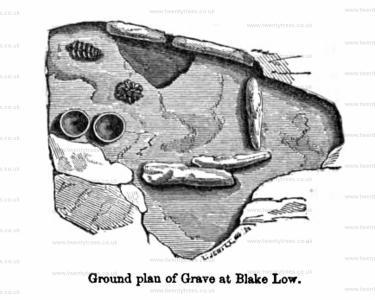
Longstone Edge. On the 25th of July we opened another barrow, at no great distance from the last, situated on a more elevated point of the "Edge." Its mutilated appearance gave rise to no very sanguine expectations of success, and we were, therefore, neither surprised nor disappointed by finding, on examination, that the mound had been thoroughly rifled. There were some very large limestones placed on edge for a considerable length in the centre of the barrow, but whether they had been portions of cists that had been removed by former excavators, or not, is uncertain. In all parts of our diggings we observed scattered pieces of bone pertaining to skeletons, both human and animal; amongst the latter were those of the horse, ox, hog, dog, water rat, and a few specimens of the beaks of birds. The only manufactured remains were two small pieces of a drinking cup, and a circular flint which has been calcined.
Middleton-by-Youlgreave. November 11th we continued the examination without success until near dark when we found a long grave in the rock parallel with the depression occupied by the former skeleton, and not more than a yard from it. It was eighteen inches deep, and covered with large stones; in it lay the skeleton of a young female, as usual on the left side, in a contracted posture. Before the face were indications of the skeleton of a very young child, and a highly-ornamented drinking cup of red clay, which lay crushed upon its side with the mouth towards the feet of the skeleton: it contained one broken instrument of flint. It was evident that the grave had been occupied by a previous tenant, whose bones, together with the remains of another drinking cup beautifully decorated, and a bit of stages horn, had been collected and placed under one of the large stones that covered the grave. This had clearly been done at the time when the female was buried. Owing to the lateness of the hour at which this interment was found, we were obliged to clear out the grave by candlelight, and thinking that something further might be discovered by day, we resumed the search on the 13th of November, but found only one rude flint arrow point in the grave; and a piece of a sandstone quern in refilling the excavation. There were many rats' bones in some parts of the mound, but not in the profusion sometimes met with.
Deepdale. 4th of August, we made a more complete investigation of the barrow at Deepdale, which was partially opened in 1845, when one extremity only of the grave was examined. It was now found to measure twelve feet in length by five in breadth at the widest end, and somewhat less at the other; its depth was 6½ feet, three feet having been cut out of the rock. The skeleton of a young person, and a few more pieces of the broken drinking cup found in 1845, were discovered at the broadest end; and some bones of a child, with casual flakes of flint, were found at the side, outside the grave. The skull of the young person who occupied the grave is remarkable for its elevatedform.
Taddington. On the 23rd of April, a peculiarly shaped barrow [Map] [Crakendale Pasture Barrow [Map]] upon Crakendale Pasture, near Bakewell, was examined. Its singularity consisted in three prolongations radiating from the central mound, which was about four feet high. On digging in various places, scattered pieces of bone, both human and animal, were found; and in the centre, which had been previously disturbed, were remains of at least three adults and one child, as well as some pieces of calcined bone, bones of rats and other animals, fragments of an ornamental drinking-cup, and a small instrument neatly cut from the tine of a stages horn. The centre of the barrow was carefully surrounded by several courses of flat stones set edgeway on the natural surface, which, if the barrow had been untouched, would have led to an easy discovery of the central cist, round which they had no doubt been placed with great regularity.
Youlgrave. On the 3rd of May, we made a second investigation of the tumulus at Bee Low [Map], near Youlgrave, which was first imperfectly opened by us in 1843, the excavation being then confined to the centre; but the mound being a bowl-shaped one, upwards of twenty yards diameter, it was thought worth while to make a further trial in it, which was begun by digging from the old cutting in the middle to the south side. The first discovery made when we had proceeded about three yards, was a skeleton lying on its left side with the knees drawn up, and the head to the east, so that the face was turned to the outside of the barrow. It was about eighteen inches below the surface of the mound, and did not seem to have been placed in a cist, although two or three courses of flat stones were carefully laid over it: near the head were three small instruments of bronze, two of them awls, and a few bits of the same metal that had been melted, and which had originally been small instruments of similar character. This skeleton having been taken up, we perceived the ground on the right or western side of the trench to decline; following this indication, we came to an irregular grave cut in the rock, the bottom about 4 feet 6 inches from the surface of the barrow: it was surrounded by a lining of small flat stones placed on edge, and within this lining was a regular pitching, like a street pavement, of clear chert stones very closely packed, extending over the whole grave; above them earth and stones had been thrown in without' order, but underneath them was the skeleton of a young person resting in the usual contracted position, with the head to the south-west, the elbows almost in contact with the thigh bones, and the hands in front of the face. At the angle formed by the bending of the knees, was a beautiful drinking-cup, only 6½ inches high, ornamented by two variations of the lozengy pattern; it still retained its upright position, and close to it was a very fine instrument of white flint, upwards of four inches long, which may have been used either as a knife or saw. While tracing out the western extremity of this grave, our attention was drawn to a very large stone, set up in a direction from S.E. to N.W., on a little higher level than the bottom of the grave, which was at length found to be one end of a rectangular cist, the other sides and cover of which were formed of similar slabs. Its internal dimensions were 3 feet 6 inches long, 2 feet wide, and 3 feet deep; and it was filled with stiff earth and small gravelly stone, amongst which, near the top, were fragments of calcined bone, and a small bronze awl or pin; removing the earth down to the floor (which was rock), we there found the bones composing the skeleton of an aged man, with a short round cranium, carefully placed in a heap in the middle, the long bones laid parallel with each other, and the skull put at the top of the heap, with the base upward. The bones being perfect, it is evident that this arrangement had been made whilst they were fresh and strong; and it is not a little singular that a similar mode of interment exists among the Patagonians, who make skeletons of their dead previous to burial. After removing these bones we found two small flints, and a piece of stag's horn at the bottom. Great quantities of rats' bones were found through the whole of the excavation, but they were observed to be most abundant and best preserved around the second interment, with which, it may be proper to mention, there was a single piece of an infant's skull, no other of its bones being found by a most careful examination. The accompanying plan represents the position of the various interments in the barrow; the flat stone shewn with burnt bones in the centre, being found in 1843.

Monsal Dale. On the 23rd of May, we resumed our labour in two parties, digging at once on either side, between our former cutting and the north and south verge of the mound [Hay Top Barrow [Map]], and carrying on the trenches towards the west, where the barrow was most perfect, the whole of the eastern edge having been carted away. In the south cutting we found an oval cist about three feet from the surface, sunk a foot in rock and lined with a few flat stones; the diameter was under a yard, but it contained the skeleton of an aged man lying on his right side, with the knees necessarily so much drawn up as to approach the face, the head pointed to the south-west: and near it was a neat ornamented vase of imperfectly baked clay, 5½ inches high, and a perforated bone pin, about six inches long. On this side the tumulus was also found part of another skull, which had been removed from some other place.
While these discoveries were being made, the excavation on the north side was equally productive, for immediately below the grass were many fragmentary human bones, amongst which we found an iron spear, with the socket broken, yet 9½ inches long; and a blue glass bead, with a spiral thread of white running through it, which objects, we were informed, had been disturbed many years before, by a man digging in the mound under the impression of its being a mineral hillock: they must have belonged to a body interred near the surface at a late or Saxon age. Proceeding deeper, we found the rock cut away for a large space about two feet lower than its ordinary level, making the entire depth from the grass rather more than four feet. At the east extremity of this excavation there was a small enclosure of flat stones, something like that on the other side, before described, containing a skeleton much contracted, and in this case lying on its lefl side, with the head to the south, accompanied by one flint arrow point.
About the middle of the excavation, in the rock, were two rather small human crania, placed side by side, near a drinking-cup 7¼ inches high, ornamented with a lozengy pattern. Upon the crown of one of the skulls was a neatly chipped instrument of grey flint, and it is singular that no trace either of the lower jaws or of any other parts of the skeletons could be seen, though no dis-arrangement had ever taken place in this part of the mound, and it is certain that the crania alone had been buried there. At a little distance from them were the skeleton of a child, and one cylindrical jet bead. These discoveries, with the occurrence of numerous broken bones, both human and animal in the upper parts of the trenches, terminated the labours of the day. A portion of the west side of the mound intervening between the cuttings being reserved for the next day's examination, when it was cut out to the level of the rock, disclosing a grave about a yard square, sunk about three feet lower. Inside this excavation was a very neat rectangular cist, 2 feet long and 18 inches wide, formed of four flat slabs of limestone, filled with limestone, gravel, and rats' bones, which being very carefully removed, allowed us to see the skeleton of a child, doubled up, with the head to the south, and a most beautiful little vase, 4⅜ inches high, completely covered with a minute chevron pattern, lying obliquely in contact with the pelvis of the child, which had become thrust into it by the pressure of the grave; the depth at which this deposit lay was about five feet from the surface of the mound. The skeleton of the child is arranged in a glass case at Lomberdale House [Map], and from the abnormal shape of the head, it is probable that death was occasioned by hydrocephalus. Many burnt bones, and disjointed bones, as before, were found in the course of the day. The plan of this interesting barrow will illustrate the foregoing account.

Stakor Hill. On the 2nd of July, we excavated the site of a barrow, most of which had been removed, on a hill near Buxton, not far from Stakor Hill. The mound had been so completely demolished, as to render it doubtful where it would be most proper to begin, and on digging in the most elevated part, we found the rock at the depth of a foot. This caused us to try in a place no higher than the level of the field, when immediately under the clods we perceived fragments of a human bone, and a little deeper a human skeleton, lying on its right side, with the knees contracted, and the head to the south. It had been deposited in a rude cist, walled round by a single course of large stones, and close to the left hip were two neatly sharpened darts of bone; near the legs was a deposit of calcined human bones, accompanied by a round-ended flint also burnt, and a little beyond them, and consequently further from the skeleton, were the unburnt remains of another individual, which had been slightly disturbed: two instruments of flint, and the lower mandible of a hawk, were found between the two, supplying the third instance in which we have observed the remains of this bird in tumuli. These interments removed, we arrived at the edge of an irregular grave, cut about a yard deep in rock, but rather lower at the south end, filled with clayey earth and small stones, amongst which we first found some bones of a child. Lower down was a female skeleton lying on the right side, with the head close to the south-east end of the grave, and the knees drawn up to accommodate the body to the limits of the excavation, which measured 3 feet by 2. Between the head and the knees was a broken drinking-cup of ruder work-manship than usual, lying on its side, with the mouth towards the latter; and a neat javelin-head of flint was found in throwing the earth out of the grave, so that its position was not ascertained. Both mastoid bones were dyed green, from contact with two small pieces of thin bronze, bent in the middle, just sufficiently to clasp the edge or lobe of the ear. There were many rats' bones in the grave. Ihis is probably the oldest interment we have found in which metal has been present- the very small quantity possessed, its application to the purpose of adornment, viewed in connection with the fact of the later interments above being accompanied by weapons of bone and flint only, bear out this opinion.
Ten Years' Digging 1853 Hob Hurst's House. On the 22nd of September, we opened a barrow near King Sterndale, called High Low [Map], which being situated in a rough plantation, was incapable of measurement; it did not appear, however, to have been very large even at first, and had evidently been reduced in size since. We excavated a good deal of the centre, which we found about three feet higher than the natural surface, upon which was a considerable quantity of charcoal, but found that the whole had been turned over and plundered, so that nothing but fragments were seen. From them it was clear that two interments had taken place in the mound, the traces of the most ancient being manifest in part of a large coarse urn, a calcined flint, and probably the charcoal; those of the more recent were the bones of an adult skeleton, which had been accompanied by a drinking-cup, and many broken bones of animals, including stags' horns, some of the latter having been tooled or sawed. Bones of the water rat were plentifully distributed amongst the stones in the more open part of the tumulus.
Another mound, in a field close by, had been so thoroughly destroyed that we did not think it worth the trouble of examination.
Smerrill. On the 13th of June, we opened the second barrow [Smerrill Barrow 1 [Map]] on the contrary side of the ravine, a mound about 9 yards across and 2 feet high, surrounded by an irregular circle of large limestones, and showing the grey surfaces of many others that jutted through its grassy covering. We began our cutting on the west side, and continued it to the centre, where, after much labour, we uncovered a large grave of irregular shape, sunk in the rock to the depth of 5 feet; its average dimensions were 8 feet by 6; it was filled with stones, and had upon its stony floor, a coating of stiff clay in which was embedded the skeleton of a tall young man, who lay On his left side with his knees drawn up, and the head in an easterly direction; owing to the wetness of the clay, the bones were in an advanced state of decomposition, having become of the consistency of cheese; the skull was narrowed and otherwise posthumously distorted by the pressure of the overlying mass; and the femur measured 19½ inches, the tibia 16. Behind the pelvis lay a very beautiful drinking cup, 8¾ inches high, the exterior entirely covered with ornament: it lay on its side upon an assemblage of implements, consisting of a bone netting rule or modelling tool, 12 inches long, made from the rib of a large animal (horse or cow), neatly rounded off at each end, and reduced to a regular breadth and thickness throughout; a dagger 4¾ inches long, a spear head 3 inches long, and four other instruments of flint, all whitened by the action of fire. The usual rats' bones were present in this undisturbed and interesting tumulus.
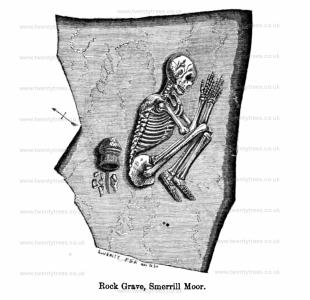
Haddon Field. On the 20th of August, after repeated disappointments from the unusual wetness of the summer, we opened a barrow [Haddon Field Barrow [Map]] on Haddon Field, near Bakewell; for access to which we were indebted to the kindness of the Rev, Frederick, and Lady Adeliza Norman, who also attended during the opening. The mound was of a regular convex form, about 16 yards diameter and not more than 4 feet high. A cutting through the centre passed downwards through about 12 inches of earth, succeeded by large limestones disposed without regularity or any apparent design, although their removal disclosed the only interment that was found: this, owing to a natural rise in the land about the middle of the barrow, was not more than 2 feet 6 inches from the surface. The skeleton lay on its left side in the usual contracted attitude, upon a thin bed of charred wood strewed on the natural level of the land a few inches only above the rock; the head pointed west south-west; the elbows were bent so as to allow the hands to be brought in front of the face; and near the lower part of the back was a small earthen drinking cup, 6½ inches high, very neatly ornamented with a vandyked pattern; close beneath which were three useful implements, an arrow head of flint that had acquired an opaque grey tint from partial calcination, a mesh rule for netting or else a potter's modelling tool, 6¼ inches long, rounded at the ends, cut from a horn of the red deer, and a very small brazen awl, which, when found, showed slight but distinct traces of its wooden handle. These objects would seem more appropriately to have accompanied a female than a male corpse, yet the size and general appearance of the bones indicate the latter as the sex of the deceased. The measurements of the long bones are -
Femur 18½in
Tibia 14¼in
Humerus 13in
The skull (see No. 237 of the list) is that of a man of upwards of forty years of age; it is a characteristic example of the ancient British type, and being more fully described in the list, calls for no further remark in this place than to observe that it possesses a peculiar flattening of the hinder part, extending from the upper edge of the occipital bone to those of the parietals adjoining the lamdoidal suture, a feature by no means uncommon in crania from barrows of the same remote antiquity, and which may be attributed to some prevailing method of nursing during infancy.
One or two teeth of animals and the least possible trace of rats' bones, with one small bit of primitive earthenware, were found in the digging, but no indication of other interments could be seen, although much of the centre of the mound was cut away in the hope of making some further discovery.
Stanshope. The other grave also contained the skeleton of a child, accompanied, like the former, by a neat spear-head of slightly burnt flint, and an equally elegant drinking cup, 6½ inches high, ornamented in a different style. In this case, it was placed at the head. The three cups are of the same clay, and are altogether so identical in fabric, though varied in ornamentation, that we may safely conclude them to be the work of the same artist. The graves were filled up with earth and stones. On the north side of the area, to which the labour of the two first days was confined, we found part of another skeleton, accompanied by bones of the water rat.
Swinscoe aka Top Low Barrow. The tenth skeleton was found in a grave cut in the rock to the depth of three feet below the floor of the barrow, consequently above six feet from the summit; it had a circle of upright flat stones round the edge, and was filled with earth and large stones, covering the skeleton of an aged man, who was deposited in the customary fashion with the knees up, behind the pelvis lay a handsome drinking cup, 7¼ inches high, decorated with a lozengy pattern, and a few chippings of fiint were found in the grave. The skull is very thick, and unusually narrow or boat-shaped naturally; the latter peculiarity is increased by posthumous distortion, caused by the settling down of the large stones in the grave, by which one side of the calvarium has been broken and curled inwards.
Stanshope. About three feet south-east of the centre was a deposit of burnt bones, lying in the earth about a foot beneath the turf, without protection. In the rock below were two circular graves, each about a yard diameter, and about four feet in depth from the surface of ther mound; they were about a yard asunder, and that to the south, being first examined, was found to contain two skeletons - one, which was that of a young person, lay at the bottom, and a little higher was the other, the remains of a child. Between the two was a large instrument of grey flint, rounded at each end, with other chippings; and close to the vertebrae of the child was a very beautiful drinking cup, 6½ inches high, with parallel bands or hoops of ornament, which stood upright when found. Above these interments, and within two feet of the surface, were the remains of another elegant drinking cup, ornamented with a chevrony pattern, the fragments of which, although lying altogether, and being carefully gathered, failed to supply more than two-thirds of the whole vessel. It is therefore probable that it had been broken before the interment for some reason with which we are unacquainted. An arrow-head of flint was found with it.
Castern. There is a small tumulus in the same field at Castern as the large barrow lately described, which we slightly examined on the 12th September, 1846, but abandoned on finding the centre converted into a limekiln, which was, nevertheless, occupied by a human skeleton extended at the bottom, which we were convinced was a modem addition, afterwards explained by information afforded by two aged persons living in the neighbourhood, who stated that the skeleton was that of one Francis Brown, who lived in a house near at hand, and who was one day found suspended by the neck from a beam, with a stool overturned near his feet, upon which discovery he was buried as a suicide in the old lime-kiln, which was very near and convenient. In the sequel, it appears, however, that poor Brown was unjustly suspected of self-destruction, as it is said that two criminals, executed at York some years afler, confessed that they were the actual perpetrators of the murder, and that they had arranged the corpse and stool in such a manner as to convey the impression that the slain man was a suicide.
Notwithstanding all this, we were confident that the mound was a barrow, and as it was full fourteen yards across and four feet high, thought that there was room to find an interment somewhere. We therefore removed a space four yards square between the kiln and the south-east edge, finding at the natural level a pavement of flat stones, whereon were many disjointed human bones belonging to several skeletons, mixed with numerous instruments of calcined flint. The most perfect skeleton lay in the middle of the pavement, with the head towards the interior of the barrow, and was accompanied by a knife, a spear-head, and other instruments of white flint. Nearer to the centre of the barrow was a deposit of burnt bones, and one implement of flint; and not far from the outside we found the remains of a finely ornamented cinerary urn, with its contents, the calcined bones lying broken and disturbed a few inches imder the turf.
In the course of the excavation, we found many bones of animals, fragments of vessels (one of which had been a drinking cup), a flat piece of sandstone rubbed hollow at one side, and a round piece of ruddle, or red war paint, which, from its abraded appearance, must have been in much request for colouring the skin of its owner. In the few instances in which this substance has been found in our tumuli, it has uniformly been associated with weapons of flint of good workmanship. Most of the very numerous flints picked up in this barrow are fair specimens.
Frederick Lukis 1865. When we were about quitting Buxton, I was beginning to make a host of friends amongst the farmers and labourers, and from them obtained lots of information; this led me in my rambles over the spot where I was informed that two stone knives had been picked up (one of which was sent to London, and the other given to Mr. Bateman). I was climbing hill after hill without any positive certainty of meeting with anything of interest, when suddenly I saw, whilst crossing a wheat field, unmistakable signs of a Barrow [Map] [Gospel Hillock Barrow [Map]]. I called on the farmer, Mr. Charles Holmes, and on pointing to the heap of stones he at once exclaimed, 'Oh, sir, I wish they were out of that, for when ploughing that field we are sadly plagued by them.' I then asked to be allowed to make a small hole with a spade in the mound; this, he said, he could not grant, but added that if I were to call on the Rev. Mr. Pickford, the owner of the property, he doubtless would grant me permission to do so. After a walk to the house, and explaining the object of my visit, Mr. Pickford very kindly gave me leave on condition of levelling the ground again.
The next day we repaired to the place, and shortly after we were met by Miss Pickford, his sister, who most obligingly gave us the history of the mound in question. She narrated as follows 'The place was called from time immemorial "The Gospel Hillock;" the mound was held in considerable estimation and reverence, as its name imports, for here, in perilous times, people repaired for religious purposes, and holy persons preached and read the scriptures, whence it had obtained the name by which it was known.' We of course assented with her on its sacred character, and we thanked her for the valuable information we had obtained, and after her departure we commenced our operations with spade and pick, not doubting that ere long by these means the exact nature of 'Gospel Hillock' would tell a different tale as to its origin and purpose.
We commenced digging over that part marked a on the plan, and after proceeding with the usual caution always necessary in working on a low barrow, our spade soon produced the signs of interment - a few human bones were perceptible, which doubtless belonged to some skeleton not far distant. In a short time at the depth of a foot a skeleton was discovered, lying partly on its back with its legs evidently doubled up. We were the more surprised at finding this subject lying upon a flat surface or level of a stone, apparently of large dimensions. The very solid floor on which this individual lay induced us to extend out search, in order to determine its extent; in doing this we discovered several conical studs of polished kimmeridge coal, drilled with two connecting holes for being strung or fastened in the usual method of that period. The skull was evidently towards the east, and the cervical vertebræ, ribs, and bones of the arms, mixed up with the legs and the fingerbones, indicating that the body had not been stretched out, but rather in a doubled up position.
In proceeding to remove the earth in a westerly direction, I suddenly touched the skull of another individual lying in nearly the same position, and ex tended towards the western part of the large stone. Whilst cautiously clearing the earth away from the head, I fortunately perceived the keen edge of a flint celt, at E, (shown on the accompanying engraving), which lay on the stone and near the south side of the shoulder of B. I could scarcely express to my companions the delight I then felt, and as neither of them were acquainted with the nature of a celt, they were the more astonished at the cause of my excitement. Before removing the instrument I endeavoured to explain to them what their uses were, among all nations ancient and modern, and tried to answer a hundred questions which the subject gave rise to. After a very learned lecture on the celt, I gently extracted the object of my joy.
This little incident caused some delay in our operations, and after having exposed the second skeleton, we cleared the edge of the stone at c, and there found a third individual lying in the trench near it, and partly touching the large stone, which we now found measured 7 ft. 8 in. in diameter by 7 ft. 3 in. wide. Fragments of bones, teeth, and a few flint chippings were found also.
Note A. D, the pick-axe struck upon a largish stone, and in pursuing our work in that direction, we came upon a perfect little chamber without any covering stone, and on working down to the same level as our trough we came upon a pavement of flattish stones, on which were laid two skeletons; the western limit being closed up by stones and dry walling. Flint flakes were more numerous here, and against the northern props there was a neat urn, or drinking vessel, of reddish clay (but in the interior of a dark colour). On the external surface were eight circular rows of vertical indents, somewhat rudely engraved. The height was about seven inches, and it was not inelegant in its out line. This urn is here engraved.
After completing the excavation round the central stone we left off our work, intending on the morrow, if possible, to raise the flat suspicious base on which the skeletons reposed, and ascertain if it might not prove a covering to some more interesting deposit. The weather, however, was too wet and stormy for our work on that day.
On the following morning we repaired to the spot with that intention, but on arriving there found that the whole had been recovered and filled, by order of Mr. Pickford - that gentleman having unfortunately concluded that we were not to return to "Gospel Hillock" and restore it to its former outline as we had promised to do.
In forwarding these few notes and observations, I beg to say that they were written by Captain Lukis for insertion in my own collectanea, but if you consider them worthy of a place in the "Reliquary," it will afford him some pleasure to know that his visit to Derbyshire was not in vain.
The Grange, Guernsey.
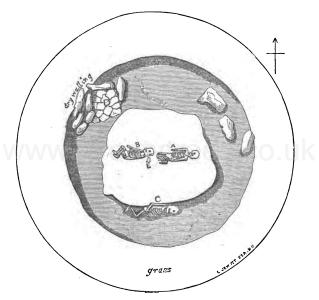
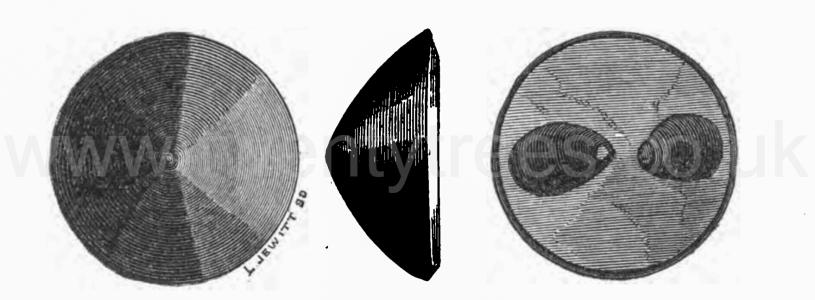
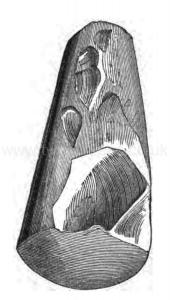
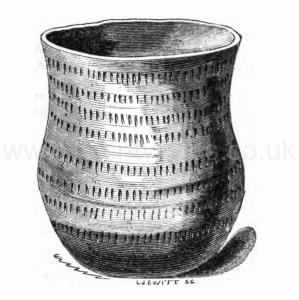
Wiltshire Archaeological Magazine 1913 V38 Pages 379-414. Avebury. 22. West Kennet Long Barrow [Map]. Length according to Hoare 344ft., to Thurnam 335ft.; E. and W. Chambered. This barrow was partially opened by Thurnam in 1859. He found one large chamber formed of six upright sarsen stones, covered by three other large sarsens; it measured 8ft. by 9ft., and 8ft. in clear height; the spaces between the large stones were filled in by a dry walling of stones of a calcareous grit, the nearest quarries of which would be about seven miles away near Calne. A similarly constructed gallery about 15ft. in length, led from the chamber to the eastern edge of the mound. Among the rubble with which the chamber was filled were the remains of six skeletons, which seem to have been in a sitting or crouching position; two of the skulls had been cleft before burial, probably before death. Bones of various animals, numerous flakes and worked flints, including one piece ground, several large mullers of flint and sarsen, part of a bone pin, and a hand-made bead of Kimmeridge shale were found. There was also a considerable quantity of pottery all in fragments, "in three of the four angles of the chamber there was a pile of such evidently deposited in a fragmentary state, there being scarcely more than two or three portions of the same vessel." This pottery consists of fragments of "drinking cup" type, and of other vessels of distinctive decoration, possibly round-bottomed, and having a hollow moulding beneath the rim.1
Thurnam thought the chamber had been previously disturbed, possibly during the Roman period. The barrow seems to have had originally a containing wall built of upright sarsens with the spaces between filled in with dry walling of oolitic stones. (For a similar walling see "Adam's Grave [Map]," under Alton Priors.) As to its present condition the chamber and gallery appear to be in a complete state of ruin, the stones lying about promiscuously. For the rest, to quote Thurnam, "Tenants in the present century (the 19th) have stripped it of its verdant turf2, cut a waggon-road through its centre, and dug for flints and chalk rubble in its sides, by which its form and proportions have been much injured." O.M. 28 S W.; A. W. II. 96; Arch. xxxviii. 403; xlii. 203, 211; Cr. Brit. Pl. 50; W.A.M. x. 130; Smith p. 154, XI. G. vi. b.; Devizes Museum Cat. 11. 23.
Note 1. See "The Development of Neolithic Pottery," by Mr. R. A. Smith, Arch. LXII. 340.
Note 2. The result of this is the rank growth of weeds and grass that now cover the mound.
In 1924 Alexander Keiller (age 34) bought Windmill Hill Causewayed Enclosure [Map] and excavated between 1925 to 1929 with Harold St George Gray (age 51). Pottery was found in the bottom of the ditches - probably Windmill Hill Pottery. Upper layers contained Peterborough Ware. Later deposits contained Grooved Ware and Beaker Potsherds suggesting continuous occupation over an extended period.
Long Stones Cove aka Devil's Quoits [Map], aka Adam and Eve, Longstone Cove, Devil's Coits, describe two large upright sarsen stones in a field to the south-west of the Avebury Henge. One of the stones fell and was re-erected in 1911. During the course of its re-erection husband and wife Benjamin and Maud Cunnington discovered a crouched skeleton with beaker ware at its foot.
